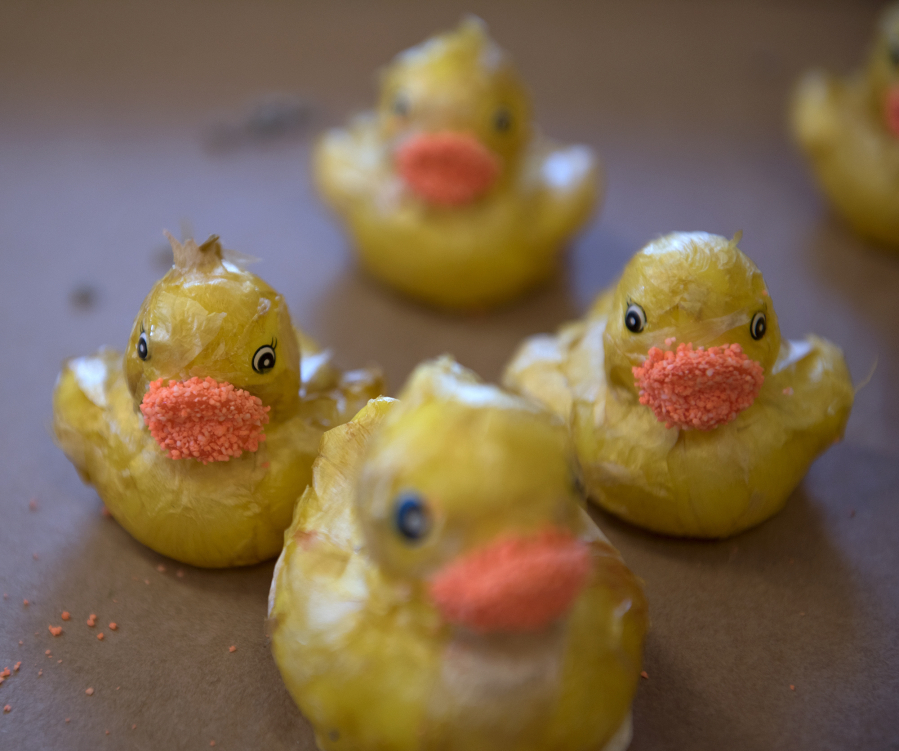BATTLE GROUND — Whether it’s Uncle Rat going downtown to find a wedding gown, a wedding supper in a hollow tree with servings of fried mosquito in a black-eyed pea, or such wedding guests as the flying moth with a tablecloth, June bug with a water jug, or Mrs. Cow who wants to dance but doesn’t know how, everything in Battle Ground’s Rose Festival Grand Floral Parade float has to be covered with plant matter.
The folk song “Froggy Went A-Courtin’ ” is the theme for Battle Ground’s float this year. After months of work, volunteers have spent the past few days putting the finishing touches on Miss Mouse’s wedding gown, Frog’s green parsley clipping paint job and the thousands of flowers that will festoon the city’s float.
The organic material is in the rules, longtime float volunteer Barbara Evans said. It is a “floral” parade, after all.
Evans was working on Frog’s eyes one day leading up to the parade, making eyelids by cutting up a foam pool noodle.
Work typically starts around early fall the year before the parade, she said, when organizers in Portland tell the Battle Ground Rose Float team the overall theme for Rose Festival.
This year’s theme is “Brilliant.”
“They have the general theme, and we just brainstorm, our own little group, until we can all agree on something,” said Evans, who’s been at it since 1993. “The ladies just say OK, this is what we visualize. Let’s put this product there, do that. It’s all by committee.”
(Most of the volunteers are women, but all are welcome, and encouraged, to participate.)
This year’s nursery rhyme theme came to them pretty quickly, said Patricia Stanfield, another volunteer.
“One of our members, Louise (Tucker), came up with the idea, and no one else had a better idea … so there we go!” she said.
Construction and decorating work typically starts in February, Stanfield said, when the roughly 50-person float group can start using the Flex-Use building in Battle Ground.
The city has built a float for the floral parade since 1955, and dozens of plaques and ribbons line the building’s walls. This year’s parade starts at 10 a.m. Saturday, winding from Portland’s Rose Quarter across the Burnside Bridge to Lincoln High School.
Team effort
After they get an idea, Tucker then puts together a scale clay model, which the welders in the group use to build a pencil-rod frame for the larger pieces of the float, like Frog and Miss Mouse.
Once they have a frame to work with, they wrap it in burlap. They seal it on with a kind of painted-on treatment that also works like a primer. Then they do some painting and apply the products — whether it’s green parsley, quinoa for a beige, coconut for purple and countless others — with gallons of glue.
“You don’t need any experience. It’s like kindergarten work. Cut and paste,” Evans said.
They have a 94-year-old woman who just joined, she said, and a 26-year-old man helping with welding.
“We teach you what you need to do. A lot of it’s trial and error.”
One volunteer, Barbara Garrison, has been building floats for about eight years.
“I keep thinking ‘You know, maybe this’ll be my last year,’ ” she said. “And then it comes up in February and I go, ‘Oh, I can’t not do it.’ ”
At home, she likes to work with pastels, mosaic and watercolors.
It’s a fun change of pace, Garrison said amid the frog’s heart-shaped banjo, papier-machelike flower petal mushrooms, and orange lentil- and green mung bean-covered snakes.
There’s also a social component, she said.
“Everybody lives fairly nearby. We’ve really become quite a little community of our own,” Garrison said. “And it’s like going back to kindergarten. Having fun.”
The volunteers work, have a lunch and chat, and she found herself not wanting to pass it up.
“It really stimulates the creative side of your brain, because you get to think about what product’s going to work best, how to make some of these figures,” she said.
The group has been at it long enough they generally know what tools, techniques and materials they’ll need to pull off their plan, Garrison said.
“We’ve had enough experience with papier-mache and with different products to know how they go on and what it takes to get them to stick and what they’re going to look like, how much texture you want or whether you want a smoother surface,” like Miss Mouse’s purple coconut product dress.
The snakes have little flowers on them made of pumpkin seeds. The owls’ feathers are made from wood shavings. The city gave the group the OK to prune the bottom of some nearby cedars to make a “skirt” for the float out of boughs.
Evelyn Dalton called herself a rookie, having participated for just a few years. She got involved after reading in the newspaper the float builders were looking for volunteers.
“It’s fun and you meet people that you don’t normally know,” she said. “We have lunch here and everybody’s so friendly. If you do something wrong it can be fixed, so there’s no pressure at all.”
What’s really fun, Dalton said, is when her kids and grandkids all go to the Harvest Days parade, where the float is also shown.
“I get to say, ‘Look at our float. I got to work on it!'”




